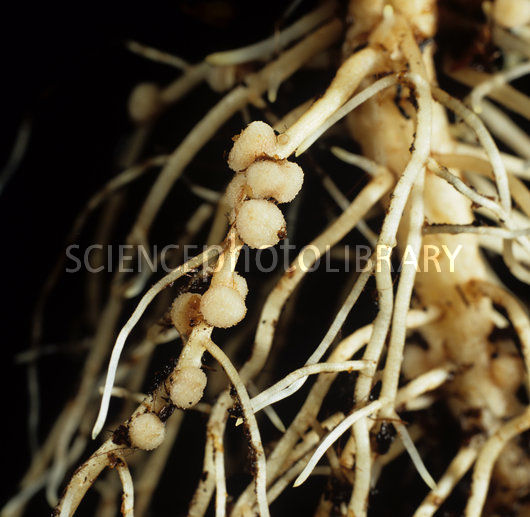|
photo credit NIGEL CATTLIN/SCIENCE PHOTO LIBRARY Nitrogen is an essential plant nutrient and a limiting factor in plant growth. The nodules on the soybean roots in the picture above contain special bacteria from the genus called Rhyzobia. An incredible exchange takes place between them that benefits them both, allowing both of them flourish. Plants are unable to use nitrogen from the air. Algae and bacteria are the only organisms capable of changing the nitrogen gas in the air into nitrogen compounds able to be used by the plants. It takes a huge amount of energy for the bacteria to break the bonds of the nitrogen gas. So within the nodule attached to the plant root, the plant supplies the energy and nutrients to the bacteria and the bacteria provides the nitrogen compounds to the plant. This association between the rhyzobium bacteria and the legume plant is an amazing example of mutualism. Each type of legume needs a specific species of rhyzobium (1)(2) For instance, the species of rhyzobium that can fix nitrogen for the soybean, cannot fix nitrogen for the pea plant. In agricultural settings, innoculants of rhyzobia are mixed with legume seeds to induce nodulation and nitrogen fixation by that legume. For instance, Alfalfa and sweet clover can be nodulated with Rhizobia meliloti True clovers can be nodulated with Rhyzobia trifolii Soyabeans with rhyzobia japonicum Peas and True vetch with Cr leguminosarium etc Soils are the most complex part of an ecosystem and and least well studied and least understood. For a nitrogen fixing plant to function its best in its specific ecosystem, it needs its own specialized rhyzobia. As well, each species of rhyzobia need a specific legume to function its best. Nitrogen fixing plants that grow on the prairies are specialists…able to survive extremes temperature fluctuations from harsh winters to hot dry summers. The rhyzobia bacteria are also specialists for our climate and conditions. These plants and their associated bacteria are part of a prairie grassland ecosystem that produced rich, thick and fertile soils called black chernozems. These incredible soils, so rich in organic matter, produced cereal crops of high yield and quality. These soils were so valuable for farming, that less than one percent of these grasslands now remain intact. (3) All the rest were ploughed and utilized for conventional tillage farming. Learning about ryzobia and their interactions in the prairie ecosystem, will help us appreciate the importance the prairie legumes plants and all the life forms(plant and animal) that depend on them for their survival. Allowing prairie legume plants to grow, increases and maintains the fertility of our soils. (1)http://extension.psu.edu/plants/crops/forages/successful-forage-establishment/inoculation-of-forage-and-grain-legumes (2)http://efotg.sc.egov.usda.gov/references/public/ia/agronomytechnote11attach.pdf_ (3)http://www.prairiesoilsandcrops.ca/articles/volume-3-6-screen.pdf
2 Comments
Jean
11/1/2014 12:24:29 am
Isn't fungus also a really important part of the soil system?
Reply
Leave a Reply. |
CategoriesAuthorManitoba is where I was born and where I have spent most of the five and one half decades of my life. I lived on the outskirts of the town of Portage La Prairie at a time when tadpoles and frogs inhabited the ditches and ponds, when there were many Monarch butterflies each summer along with dragon flies and grasshoppers. Redwing blackbirds perched the cattails of the ditches. As children we picked dandelions for bouquets and made wishes before blowing dandelion seed heads. We searched clover for lucky four leaves and rolled on the grass…there was no concern of poisonous herbicides. The grass was thick. Wherever we dug…there were earthworms Archives
September 2015
|
Photo used under Creative Commons from wackybadger

 RSS Feed
RSS Feed
